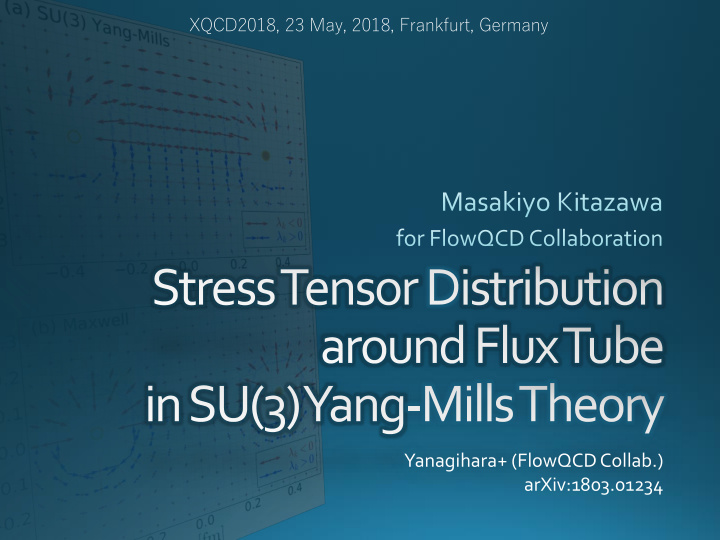



XQCD2018, 23 May, 2018, Frankfurt, Germany Yanagihara+ (FlowQCDCollab.) arXiv:1803.01234
Newton Action-at-a-distance
Faraday Local interaction “Action through medium”
Pressure S
Pressure Generally, F and n are not parallel v fluid F S elastic body S S Stress Tensor In thermal medium Landau Lifshitz
E pulling Parallel to field: Pulling pushing Vertical to field: Pushing
length: pulling pushing Distortion of field, line of the force Propagation of the force as local interaction Absolute value of the force between sources
length: pulling pushing Distortion of field, line of the force Propagation of the force as local interaction Absolute value of the force between sources
Formation of the flux tube confinement
Formation of the flux tube confinement Previous Studies on Flux Tube Potential Action density Color-electric field Cea+ (2012) so many studies… Cardoso+ (2013)
Lattice simulation SU(3) Yang-Mills a=0.029 fm R=0.69 fm t/a 2 =2.0 length: Clearly gauge invariant Distortion of field, line of the force Propagation of the force as local interaction Absolute value of the force between sources
SU(3) Yang-Mills Maxwell (quantum) (classical) Propagation of the force is clearly different in YM and Maxwell theories!
: nontrivial observable on the lattice Definition of the operator is nontrivial ① because of the explicit breaking of Lorentz symmetry ex: ② Its measurement is extremely noisy due to high dimensionality and etc.
Luscher 2010 Narayanan, Neuberger, 2006 Luscher, Weiss, 2011 t: “flow time” leading dim:[length 2 ] • diffusion equation in 4-dim space • diffusion distance • “continuous” cooling/smearing
Luescher, Weisz, 2011 Suzuki, 2013 remormalized operators an operator at t>0 of original theory original 4-dim theory t 0 limit
gauge-invariant dimension 4 operators
Suzuki, 2013 Suzuki coeffs. Remormalized EMT
FlowQCD, PR D94 , 114512 (2016) Conventional Our Approach Integral Method Gradient Flow Method Thermodynamic relations Take expectation values Other progress: shifted boundary Giusti and Pepe (2014~) Jarzynski’s equality Caselle+ (2018); Talk by Nada, Monday
FlowQCD, Expectation values of T mn PR D94 , 114512 (2016) SU(3) YM theory Wilson gauge action Parameters: • N t = 12, 16, 20-24 • aspect ratio 5.3<N s /N t <8 • 1500~2000 configurations Scale from gradient flow FlowQCD 1503.06516
clover+plaq clover : strong discretization effect : over smeared : Linear t dependence
Continuum extrapolation strong discretization effect Small t extrapolation
Black line: continuum extrapolated
Range2 Range1 Range3 Black line: continuum extrapolated Fitting ranges: Systematic error from the range-1: choice of fitting range range-2: ≈ statistical error range-3:
Excellent agreement with Error includes integral method statistical error choice of t range for t 0 limit High accuracy only with uncertainty in a L MS ~2000 confs. total error <1.5% for T>1.1T c See also, talk by Nada, Monday
Taniguchi+ (WHOT-QCD), PR D96 , 014509 (2017) no linear window Agreement with integral method except for N t =4, 6 No stable extrapolation for N t =4, 6 Suppression of statistical error Physical mass: Kanaya+ (WHOT-QCD), 1710.10015
FlowQCD, PR D96 , 111502 (2017) t -independent plateau in all channels conservation law Confirmation of linear-response relations New analysis of specific heat
Wilson loop APE smearing for spatial links Multi-hit for temporal links No gradient flow for W(R,T) potential at b=6.6 (a=0.038 fm)
SU(3) Yang-Mills (Quenched) Wilson gauge action Clover operator APE smearing / multi-hit fine lattices (a=0.029-0.06 fm) continuum extrapolation Simulation: bluegene/Q@KEK R=0.92 fm R=0.69 fm R=0.46 fm
mid point b=6.819 ( a =0.029 fm ), R =0.46 fm Appearance of plateau Grand state saturation for t/a 2 <4, T/a>15 under control
t/a 2 =1.0 Wilson loop t/a 2 =3.0 t/a 2 =4.0 b=6.819 ( a =0.029 fm ), R =0.46 fm Appearance of plateau Grand state saturation for t/a 2 <4, T/a>15 under control
a 0 extrapolation with fixed t
Range2 Range1 Range3 a 0 extrapolation with fixed t Then, t 0 with three ranges
From rotational symm. & parity EMT is diagonalized in Cylindrical Coordinates Degeneracy in Maxwell theory
Separation Degeneracy: Separation: Nonzero trace anomaly
Separation Degeneracy: Separation: Nonzero trace anomaly
Force from Potential Force from Stress
Force from Potential Force from Stress
Force from Potential Force from Stress
Yanagihara+, in prep.
Abelian-Higgs Model flux-tube solution w/ monopoles Nielsen, Olesen (1973) model for QCD vacuum (dual-Ginzburg-Landau) describe symmetry breaking/restoration nonzero trace anomaly
Abelian-Higgs Model GL parameter: Infinitely long tube degeneracy type-I : type-II : Luscher, 1981 conservation law Bogomol’nyi bound :
Bogomol’nyi bound : de Vega, Schaposnik, PR D14 , 1100 (1976).
Type-I Type-II Gauge dominant Higgs dominant conservation law No degeneracy bwT rr & T qq
Abelian-Higgs Lattice Type-I; infinitely long Suggest type-I (if dual-SC picture is correct)? Translationally-invariant flux tube is not formed.
First non-perturbative analysis of the stress tensor distribution in quark-anti-quark systems New insights into the nature of the flux tube “Action -at-a- distance” force is given by the sum of local interaction. Non-trivial degeneracy in mid-plane T rr >0 type-I vacuum? / T rr ~T qq Is R still small?
First non-perturbative analysis of the stress tensor distribution in quark-anti-quark systems New insights into the nature of the flux tube “Action -at-a- distance” force is given by the sum of local interaction Non-trivial degeneracy in mid-plane T rr >0 type-I vacuum? / T rr ~T qq Is R still small? So many future studies Nonzero temperature / excited states EMT distribution inside hadrons Model study of the flux tube with finite length
Recommend
More recommend